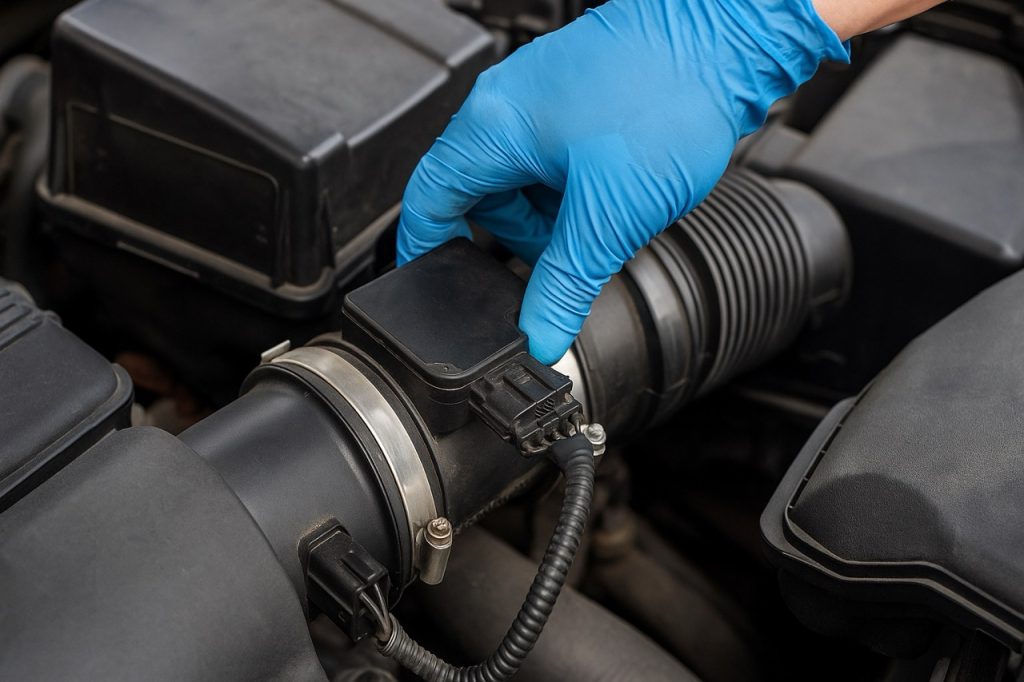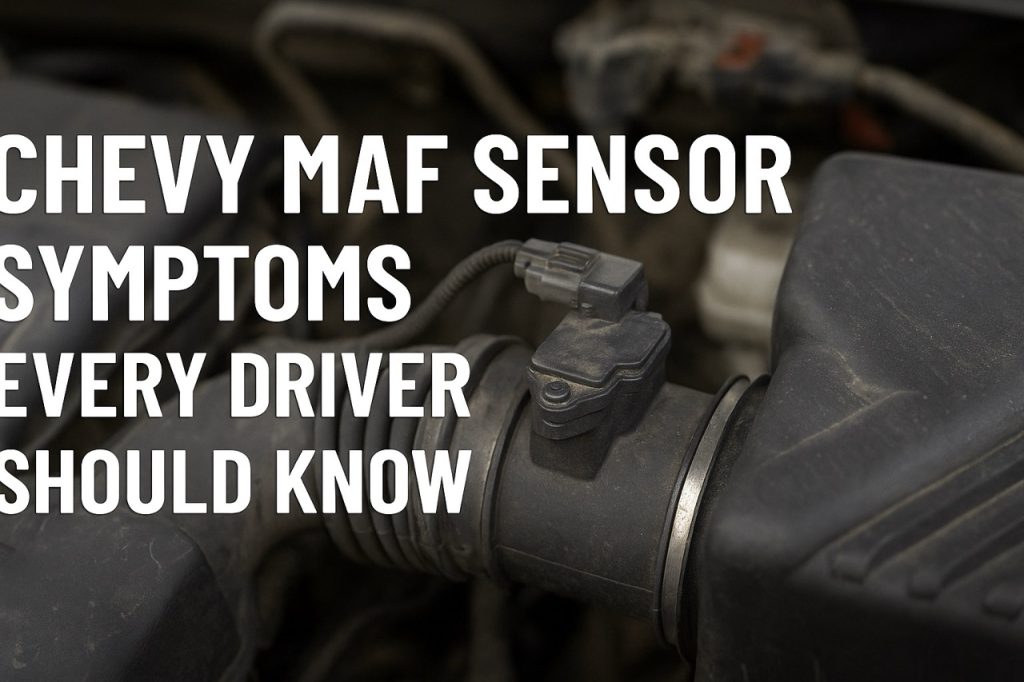Chevy MAF Sensor Symptoms Every Driver Should Know (how do you fix a mass air flow sensor for Chevy): The mass air flow (MAF) sensor in your Chevy is one of the most important parts of the engine management system. It measures the air entering the engine so the computer can deliver the right amount of fuel. When this sensor gets dirty or fails, the computer makes bad calculations, and your car shows clear warning signs.
Understanding these Chevy MAF sensor symptoms will help you avoid costly repairs and keep your Silverado, Cruze, or Malibu running smoothly.

Rough Idle, Stalling, or Hard Starts
One of the most common symptoms of a bad MAF sensor Chevy drivers report is a rough idle. Your truck or car may shake when sitting at a stoplight, stall unexpectedly, or refuse to start smoothly.
In the Chevy Malibu, a failing sensor often shows up as stalling in low-speed traffic. In a Chevy Cruze, drivers often complain of hard starting in colder weather. Even the rugged Silverado is not immune, many owners describe their truck struggling to hold a steady idle, especially after towing or hauling.
Chevy MAF Sensor Symptoms Every Driver Should Know (how do you fix a mass air flow sensor for Chevy):
These dirty MAF sensor symptoms Chevy vehicles develop are often solved by simply cleaning the sensor with the right cleaner.
Hesitation and Poor Acceleration
If you press the gas pedal and your Chevy hesitates, jerks, or feels sluggish, you may be experiencing symptoms of a bad MAF sensor when accelerating Chevy.
This is particularly noticeable in the Chevy Silverado when trying to merge on highways or pull heavy loads. Many truck owners search for Chevy Silverado bad MAF sensor symptoms after noticing that their engine no longer delivers smooth power.
Compact cars like the Chevy Cruze may jerk during acceleration or feel like the engine is choking when the MAF isn’t working correctly. These Chevy Cruze MAF sensor symptoms are often mistaken for transmission problems, but the root cause is a failing airflow reading.
Drop in Fuel Economy
Another red flag for Chevy mass air flow sensor problems is poor gas mileage. A dirty or failing sensor may cause the engine to run too rich (too much fuel) or too lean (not enough fuel). Either way, you’ll see more frequent stops at the pump.
Owners often search for Chevy mass air flow sensor problems after noticing a sudden loss in miles per gallon. This issue is especially common in Silverado mass air flow sensor symptoms, since heavy trucks already consume more fuel, making a bad sensor even more costly.
Check Engine Light and Error Codes
The check engine light is one of the most direct ways your Chevy tells you something is wrong. When the MAF sensor fails, the computer often logs codes like P0101 (MAF performance issue), P0102 (low input), or P0103 (high input).
If you’re wondering how can you tell if the MAF sensor is bad, scanning for these codes is a good first step. Many drivers also ask how do you know when your MAF sensor is bad, and the combination of a check engine light plus rough running or poor acceleration is the clearest answer.
Model-Specific Chevy MAF Sensor Symptoms
While most issues overlap, different Chevy models show these problems in unique ways:
- Chevy Silverado: Most often shows bad MAF sensor symptoms Chevy Silverado like hesitation under towing load, rough idle after long drives, and reduced throttle response.
- Chevy Cruze: Drivers report Chevy Cruze bad MAF sensor symptoms such as jerking when accelerating, hard cold starts, and sudden drops in fuel efficiency.
- Chevy Malibu: A failing sensor often leads to Chevy Malibu MAF sensor symptoms like stalling at stoplights, hesitation when merging, and poor gas mileage.
Whether you own a truck, sedan, or compact, Chevy mass air flow sensor problems show up as the same three core issues: acceleration trouble, rough idle, and wasted fuel.
What To Do If You Notice These Symptoms
If you recognize Chevy MAF sensor symptoms, the first step is to check whether the sensor is dirty rather than broken. A can of MAF sensor cleaner is inexpensive and often restores performance in just minutes.
If cleaning doesn’t solve Chevy mass air flow sensor problems, replacement may be necessary. The cost of a new sensor varies by model but is often much cheaper than letting the problem persist and damage other parts.

Here is more detailed guide how to fix mass air flow sensor problems chevy:
How to Fix Chevy Mass Air Flow Sensor Problems (Step by Step)
Once you’ve recognized the Chevy MAF sensor symptoms, whether it’s rough idle in your Malibu, hesitation when accelerating in your Silverado, or jerking on the Cruze, the next step is fixing the issue before it gets worse.
The good news? Most Chevy mass air flow sensor problems are caused by dirt, dust, or minor air leaks, not a dead sensor. That means you can often solve the problem at home in less than 30 minutes with the right tools.
Step 1: Confirm it’s the MAF sensor
- Use an OBD-II scanner to check for codes like P0101, P0102, or P0103.
- Pay attention to symptoms like Chevy Silverado bad MAF sensor symptoms (hesitation under load) or Chevy Cruze bad MAF sensor symptoms (hard starts).
- Rule out other causes such as spark plugs or clogged filters.
Step 2: Inspect the basics
- Check your air filter, a dirty filter restricts airflow and mimics dirty MAF sensor symptoms Chevy vehicles often show.
- Inspect the intake boot and hoses for cracks or loose clamps (especially common in the Cruze).
- Make sure the MAF sensor is installed correctly (arrow pointing toward the engine).
Step 3: Clean the MAF sensor
- Buy a can of CRC Mass Air Flow Sensor Cleaner (never use throttle body, brake, or carb cleaner).
- Remove the MAF sensor from the intake housing.
- Spray 10–15 short bursts of cleaner directly onto the sensor wires/film.
- Let it air dry for 10 minutes before reinstalling.
Cleaning usually resolves most Chevy mass air flow sensor problems like rough idle, poor acceleration, and bad fuel economy.
Step 4: Reset and relearn
- Clear codes with a scanner, or disconnect the battery for 10 to 15 minutes.
- Let the engine idle for a few minutes, then take a short drive so the ECU relearns airflow values.
Step 5: Replace if necessary
If cleaning doesn’t solve symptoms of bad MAF sensor Chevy, replacement may be the only option. Always use an ACDelco OEM MAF sensor for reliability; cheaper sensors often cause recurring problems.
Most Chevy MAF sensor symptoms, whether you’re driving a Silverado, Cruze, or Malibu, come down to a dirty or weak sensor. Cleaning it with the right spray usually fixes the problem. If not, replacement is straightforward and prevents ongoing Chevy mass air flow sensor problems that affect acceleration, idle, and fuel economy.
Conclusion
From the Chevy Silverado bad MAF sensor symptoms like sluggish towing power to the Chevy Cruze MAF sensor symptoms such as jerky acceleration, airflow problems affect every model differently, but always point to the same cause: inaccurate air measurement.
If you’ve been wondering how do you know when your MAF sensor is bad, the answer is simple: rough idle, poor acceleration, low fuel economy, and a check engine light are the clearest signs.
Don’t ignore these symptoms of a bad MAF sensor Chevy owners commonly face. A simple cleaning or affordable replacement could save you from bigger repairs down the road.
Related Articles:
